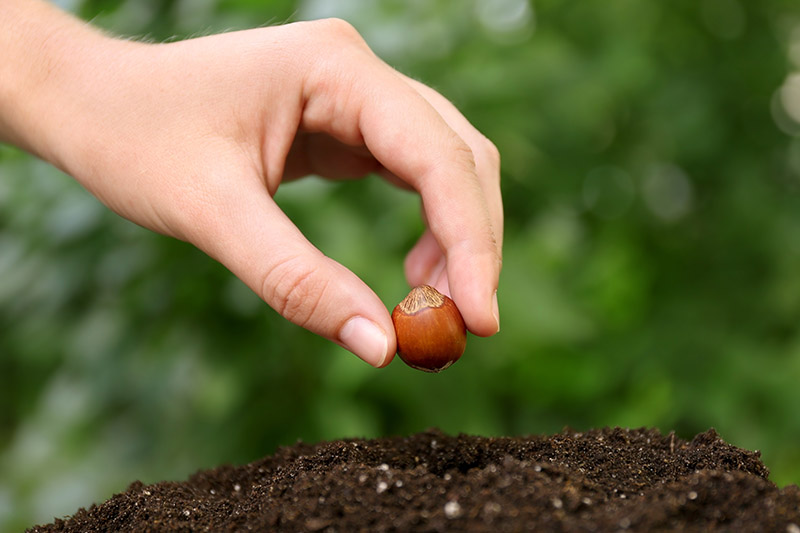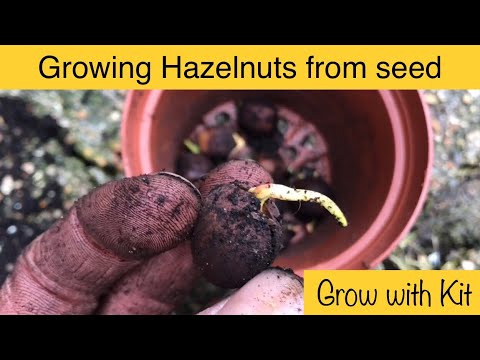To grow hazelnuts from seed, follow these steps: Select healthy nuts, soak them in water, prepare the soil, plant the nuts, and water regularly. Growing hazelnuts from seed is a rewarding and enjoyable activity.
Hazelnut trees are not only aesthetically pleasing but also provide delicious and nutritious nuts. If you have access to fresh hazelnuts, you can easily grow your own hazelnut trees from seed. In this guide, we will outline the simple steps you need to take to successfully grow hazelnuts from seed.
From selecting the right nuts to planting them in the soil, this process can be both educational and fruitful. So, let’s get started on your journey to growing your own hazelnuts right in your backyard.

Credit: gardenerspath.com
The Basics Of Growing Hazelnuts From Seed
Choosing the Right Hazelnut Species: When it comes to growing hazelnuts from seed, it is important to choose the right species that is suitable for your climate and soil conditions.
Collecting and Preparing Hazelnut Seeds: Start by collecting mature hazelnut seeds from healthy and disease-free trees. Remove any outer husks and wash the seeds thoroughly to remove any remaining debris. This will help to prevent any fungal infections or diseases.
Germinating Hazelnut Seeds: To germinate hazelnut seeds, you can either stratify them or use the damp paper towel method. Stratification involves exposing the seeds to cool temperatures for a period of time to simulate winter conditions. Alternatively, you can place the seeds between damp paper towels and keep them in a warm, dark place until they start to sprout.
| Choosing the Right Hazelnut Species | Collecting and Preparing Hazelnut Seeds | Germinating Hazelnut Seeds |
|---|---|---|
| Select a species suitable for your climate and soil conditions | Collect mature seeds from healthy trees and remove outer husks | Stratify the seeds or use the damp paper towel method |
| Wash the seeds thoroughly to remove debris | Expose seeds to cool temperatures or keep them warm and dark |
Step-by-step Guide To Planting Hazelnut Seeds
Planting hazelnuts from seed can be a rewarding experience. Here is a step-by-step guide to help you successfully grow hazelnuts:
- Choose a location that receives full sun, as hazelnuts thrive in sunlight.
- Ensure the soil is well-drained and has a pH level between 6.0 and 7.5.
- Avoid areas with strong winds, as it can damage the young hazelnut seedlings.
- Clear the planting area of any weeds or grass.
- Loosen the soil with a garden fork or tiller to improve drainage.
- Incorporate organic matter, such as compost, to enrich the soil.
- Gather hazelnut seeds from mature, healthy trees.
- Place the seeds in a container with damp sand and store them in a cool environment for stratification.
- After stratification, sow the seeds about 1-2 inches deep in the prepared soil.
- Water the seedlings regularly, keeping the soil consistently moist.
- Apply a layer of mulch around the base of the plants to conserve moisture and suppress weed growth.
- Protect the young seedlings from pests and provide support if needed.
By following these steps and providing proper care, you can grow hazelnuts from seed and enjoy the fruits of your labor.
Nutrient Requirements And Pest Control For Hazelnut Trees
Understanding the nutritional needs of hazelnut trees is essential for their successful growth. Hazelnut trees require a well-balanced combination of nutrients to thrive. The three major elements, nitrogen, phosphorus, and potassium, are essential for hazelnut tree health. Nitrogen helps in the growth of leaves and stems, phosphorus promotes root development and flowering, and potassium aids in overall tree health and disease resistance. It is important to properly fertilize hazelnut trees according to their specific nutrient requirements.
Common pests and diseases can affect the health of hazelnut trees. Aphids, mites, and caterpillars are some common pests that can damage the leaves and nuts of hazelnut trees. Disease-causing organisms, such as Eastern Filbert Blight and Big Bud Mite, can also weaken the trees. Implementing natural pest control methods, such as regular inspections and maintaining a clean orchard, can help prevent and mitigate pest infestations.
In conclusion, understanding the nutrient requirements and implementing proper pest control measures are crucial for ensuring the successful growth of hazelnut trees. By providing the necessary nutrients and protecting against pests, hazelnut trees can thrive and produce healthy, abundant nuts.
Pruning And Training Hazelnut Trees For Optimal Growth
Pruning hazelnut trees is essential for shaping their growth and ensuring optimal health and productivity. One important aspect of pruning is maintaining the desired shape and structure of the trees. This can be achieved by carefully selecting and trimming the branches to encourage a strong central leader or an open center shape. By removing any damaged or crossing branches, you can improve the air circulation within the tree, allowing for better sunlight penetration and reducing the risk of disease.
It is also important to regularly thin out any overcrowded branches to ensure that each branch receives sufficient nutrient supply. Training the hazelnut trees in a specific shape not only provides aesthetic appeal but also facilitates efficient harvesting and better exposure to sunlight, enhancing overall growth and yield.
Harvesting And Storing Hazelnuts
Harvesting and storing hazelnuts is a crucial step in being able to enjoy their delicious flavor throughout the year. It’s important to recognize when hazelnuts are ready for harvest to ensure optimal taste and quality. The best indicator is the color of the outer husk, which should change from green to brown. You can also check for a slightly loose husk and a dry, papery texture. Harvesting hazelnuts can be done by gently twisting the nuts off the tree, taking care not to damage the branches.
Once harvested, it is crucial to properly handle and store hazelnuts to keep them fresh. After removing the husks and drying the nuts, store them in an airtight container in a cool, dark place. This will help to prevent spoilage and preserve the delicious flavor of the hazelnuts for months to come.
Myths And Misconceptions About Growing Hazelnuts From Seed
Myths and Misconceptions about Growing Hazelnuts from Seed
Hazelnuts are a popular and delicious nut that can be grown from seed. However, there are several myths and misconceptions surrounding the process of growing hazelnuts from seed that need to be addressed. Dispelling these common myths is important in order to provide accurate information to those interested in propagating hazelnuts from seed.
| Myth | Facts |
| Hazelnut seeds have low viability. | Hazelnut seeds can have high viability if properly stored and treated. |
| It takes a long time for hazelnut seeds to germinate. | Hazelnut seeds can germinate within a few weeks under optimal conditions. |
| Propagating hazelnuts from seed is difficult. | With the right knowledge and techniques, propagating hazelnuts from seed can be relatively straightforward. |
| Hazelnut seedlings have poor vigor. | Hazelnut seedlings can display vigorous growth and establish well if given proper care. |
Addressing concerns regarding seed viability and vigor is crucial when it comes to growing hazelnuts from seed. By dispelling these common myths, we can provide aspiring hazelnut growers with accurate information and empower them to successfully propagate hazelnuts from seed.
Frequently Asked Questions For How To Grow Hazelnuts From Seed
Can You Grow Hazelnuts From A Nut?
Yes, you can grow hazelnuts from nuts. Plant the nuts in well-draining soil, about 2 inches deep. Water regularly and provide plenty of sunlight. In 4-5 years, the tree will produce hazelnuts.
Do You Need 2 Hazelnut Trees To Get Nuts?
No, you don’t need 2 hazelnut trees to get nuts. One tree can produce nuts on its own.
Can You Grow A Hazelnut Tree From A Seed?
Yes, you can grow a hazelnut tree from a seed. Simply plant the seed in well-draining soil, keep it moist, and provide adequate sunlight.
Is Hazelnut A Tree Or Bush?
Hazelnut is a tree, not a bush. It belongs to the genus Corylus and produces edible nuts.
Conclusion
Growing hazelnuts from seed can be a fulfilling and rewarding experience for any avid gardener. By following the step-by-step process outlined in this blog post, you can successfully cultivate your own hazelnut trees. Remember to provide the right conditions, including well-drained soil and full sun.
Regular pruning and maintenance will ensure healthy growth and optimal nut production. With patience and care, you’ll be able to enjoy a bountiful harvest of delicious hazelnuts in no time! Happy growing!

